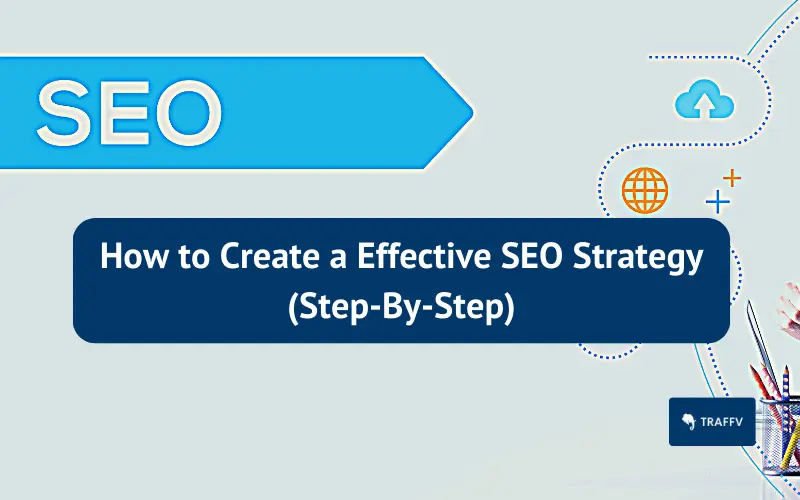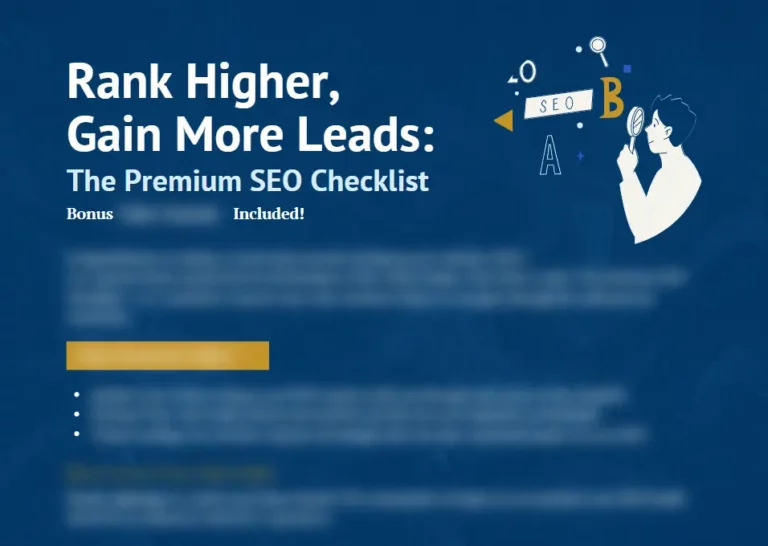Today, we’re going to dive into the magical world of SEO strategy – that elusive pot of gold at the end of the digital marketing rainbow.
Ready to learn how to create a killer SEO strategy that’ll have those website visitors coming in like it’s a Black Friday sale?
Let’s get started!
TL:DR
- SEO strategy is a long-term plan to improve your website’s visibility and relevance in search engines for your target keywords and audience.
- Define goals, perform keyword research, analyze competitors, optimize website, create and promote content, measure and improve results.
- Continuous process that requires constant monitoring, testing, and refinement to adapt to changing user behavior and search engine algorithms.
What is an SEO Strategy?
It’s a well-thought-out plan that guides you in optimizing your website to rank higher on search engine results pages (SERPs).
Higher rankings mean more visibility, more traffic, and ultimately, more conversions.
Cha-ching!
But why should you care about SEO strategy?
Here’s the deal: it’s the difference between fumbling around in the dark and having a clear roadmap to success.
Having an effective SEO strategy in place makes it easier to achieve your digital marketing goals and keeps you ahead of the competition.
Mobile SEO Strategy
In today’s digital era, if your website isn’t mobile-friendly, you’re basically living in the Stone Age.
Mobile SEO is all about making your site easy to navigate, responsive, and fast-loading on mobile devices.
Why?
Because more than half of all web traffic comes from mobiles, and Google’s mobile-first indexing means that your mobile site’s performance matters more than ever.
Here’s what you should focus on:
- Mobile-friendliness: Use a responsive design, readable text, and clickable buttons
- Page speed: Optimize images, minify code, and leverage browser caching
- User experience: Ensure smooth navigation, easy-to-find content, and no annoying pop-ups
Local SEO
If your business targets a local audience, you’ll want to make sure you’re ranking high for local searches.
After all, 46% of all Google searches are for local information!
To boost your local SEO, focus on these three factors:
- Location: Make sure your business address is accurate and consistent across all online platforms
- Relevance: Use locally-focused keywords in your content, metadata, and anchor text
- Prominence: Encourage customers to leave positive reviews on Google and other review sites
Maximize your local SEO efforts by setting up and optimizing your Google My Business (GMB) profile, embedding Google Maps on your website, and engaging with customers via Google Reviews.
Video SEO Strategy
Did you know that YouTube is the world’s second-largest search engine?
Yep, you read that right.
Video SEO is all about optimizing your video content to rank higher in search engine results, attract more views, and increase engagement.
Here’s how to create a video SEO strategy that’s worthy of the red carpet:
- Quality over quantity: Invest in high-quality equipment and editing software
- Get creative with titles and descriptions: Use relevant keywords and compelling language
- Go beyond YouTube: Embed videos on your website and share them on social media
Don’t forget to take advantage of video-specific features like YouTube Shorts, YouTube Live, and YouTube Premiere to boost your video SEO even further.
Voice Search Strategy
With the rise of voice-activated devices like Amazon’s Alexa and Google Home, it’s crucial to optimize your website and content for voice queries.
To make sure your site is voice search-friendly, consider these tips:
- Use natural language: Write in a conversational tone that mimics how people speak
- Focus on questions: Optimize your content for commonly asked questions in your niche
- Add FAQ pages: Create dedicated FAQ pages to answer common voice search queries
International SEO Strategy
If your business targets a global audience, you’ll want to make sure your website is optimized for different languages and cultures.
This can be a bit tricky, but here are some pointers to help you conquer the world of international SEO:
- Use hreflang tags: These tags tell search engines which language version of your site to display
- Choose between subdomains and subdirectories: Both have their pros and cons, so pick what works best for your site’s structure and target audience
Steps to Create an SEO Strategy
Step 1: Align SEO with Business Goals and Define KPIs
Alright, my fellow marketers, let’s talk about setting goals for your SEO strategy.
You know, those business objectives that you want to achieve? Yeah, those.
To create a killer SEO strategy, you’ve got to make sure your SEO goals align with your business goals.
For example, if your goal is to increase brand awareness, your SEO strategy should focus on boosting visibility in search results.
Now, let’s get SMART with our KPIs (Key Performance Indicators).
You know, like Specific, Measurable, Achievable, Relevant, and Time-bound.
For instance, if your goal is to increase organic traffic by 20% in 6 months, you can use tools like Google Analytics and Google Search Console to set and track your progress.
Step 2: Benchmark Your Current SEO Performance
Before diving headfirst into your SEO strategy, it’s essential to know where you stand.
Perform a comprehensive SEO audit and analysis using tools like SEMrush, Ahrefs, and Moz.
These babies will help you identify your strengths and weaknesses, so you know where to focus your efforts.
And don’t leave out the visuals! Google Data Studio and Tableau can help you create and visualize your SEO baseline report, making it easier to understand your current performance.
Now you’re ready to level up!
Step 3: Analyze Your Competitors’ SEO Strategies
To stay ahead of the game, you’ve got to know what your competitors are up to.
Tools like SEMrush, Ahrefs, and Moz can help you perform a competitive SEO analysis and research.
This way, you can identify their opportunities and threats and use that knowledge to your advantage.
And let’s not forget about the power of SWOT analysis and gap analysis.
Use these methods to create and visualize your competitive SEO report, so you know where you stand compared to your rivals.
Knowledge is power, folks!
Step 4: Perform Keyword Research and Build Topic Clusters
Step up your SEO game with some top-notch keyword research.
Tools like SEMrush, Ahrefs, and Moz can help you find the most relevant keywords for your strategy.
Then, group those keywords into topics and subtopics based on search intent and user journey.
You can create content clusters and pillar pages based on these keyword topics, making it easier for users and search engines to understand your content.
The result? Better SEO performance and happier users!
Step 5: Audit Your Site’s Existing Content
Take a moment to audit your site’s existing content to determine what to keep, improve, or remove.
Tools like SEMrush, Ahrefs, and Moz can help you perform a content audit and analysis, so you know what’s working and what’s not.
Create a content inventory, content matrix, and content scorecard to help visualize your content audit report.
This way, you can make informed decisions about your content strategy moving forward.
Step 6: Align Content with Search Intent
To create SEO content that resonates with your audience, align your content with search intent and user journey.
Analyze search intent and user behavior using tools like Google Search Console and Google Analytics.
Use buyer personas and customer journey maps to create and visualize your content strategy, ensuring your content meets the needs of your audience.
They’ll love you for it, trust us!
Step 7: Focus on Content Design
Content design is crucial for engaging and informing your audience.
Use tools like Grammarly and Hemingway to check and improve your content quality and readability.
And don’t forget about visuals!
Tools like Canva and Unsplash can help you create and add eye-catching visual elements to your content, making it more appealing and easier to digest.
Step 8: Improve Your On-Page SEO
Optimize your content for search engines and users by improving your on-page SEO.
Use tools like Yoast SEO and Rank Math to check and enhance factors like title tags, meta descriptions, headings, and images.
Enhance your on-page SEO features, such as rich snippets, site navigation, and authority, by using schema markup, internal links, and external links.
Your website will be an SEO powerhouse in no time!
Step 9: Find and Fix Technical SEO Issues
Technical SEO issues can impact your site’s performance and usability, so it’s essential to find and fix them.
Use tools like Google PageSpeed Insights, Google Mobile-Friendly Test, and Screaming Frog to check and improve your site’s speed, mobile-friendliness, security, and more.
Fix issues like broken links, duplicate content, and crawl errors using tools like Sitebulb to keep your site running smoothly.
Your users will thank you!
Step 10: Consider Your Resources
Developing an SEO strategy requires considering your resources and budget.
Use tools like Google Sheets, Trello, and Asana to plan and manage your SEO resources and tasks.
Need some extra help?
Platforms like Upwork and Fiverr can connect you with SEO experts and freelancers who can lend a hand.
Step 11: Plan and Implement Off-Page SEO Strategies
A solid off-page SEO strategy can help improve your site’s authority and reputation.
Find and analyze backlink opportunities and competitors using tools like SEMrush, Ahrefs, and Moz.
Plan and execute off-page SEO strategies like guest posting, outreach, and content marketing using tools like BuzzSumo and Mailchimp.
Step 12: Optimize for Mobile, Local, Video, Voice, and International SEO
Don’t forget to optimize your SEO strategy for different scenarios based on your goals and audience.
Use tools like Google Mobile-Friendly Test, Google PageSpeed Insights, and Google Search Console to optimize your site and content for mobile devices, local customers, video, voice, and international users.
The more, the merrier!
Step 13: Create, Improve, and Update Your Content
Regularly create, improve, and update your content to keep it relevant and engaging.
Use tools like Google Docs, WordPress, and Medium to create and publish your content. Improve and update your content based on keyword performance and user feedback using tools like SEMrush, Ahrefs, and Moz.
And don’t forget about those headlines!
CoSchedule Headline Analyzer and BuzzSumo Headline Generator can help you create catchy and compelling headlines that grab attention.
Step 14: Integrate SEO with Marketing and Branding Strategies
Integrate your SEO strategy with your marketing and branding strategies to maximize results.
Measure and analyze seo analytics on your marketing and branding goals using tools like Google Analytics and Google Search Console.
Integrate SEO with your marketing and branding campaigns like email marketing, social media marketing, and influencer marketing using tools like HubSpot CRM and Mailchimp CRM.
Step 15: Analyze, Measure, and Track Your Strategy’s Success
Finally, analyze, measure, and track your SEO strategy’s success using various metrics and tools.
Use tools like Google Analytics, Google Search Console, SEMrush, Ahrefs, and Moz to track and report your SEO performance using common SEO metrics like organic traffic, rankings, conversions, and bounce rate.
Create and visualize your SEO reports using charts, graphs, and tables with tools like Google Data Studio and Tableau.
Examples of Effective SEO Practices
It can be overwhelming to create a solid SEO strategy that actually delivers results.
We’ll break down some examples of effective SEO practices that you can start implementing today.
1. Writing Compelling Meta Descriptions
First things first, let’s talk about meta descriptions.
These little snippets of text are your online sales pitch, summarizing your content and convincing users to click on your site.
How do you craft a killer meta description?
Here are some tips:
- Use relevant keywords and phrases that match the user’s search intent and query.
- Write concise and clear sentences that describe the main benefit or value proposition of your content.
- Include a clear call-to-action that encourages users to take the next step or learn more.
Tools like Yoast SEO and Rank Math can help you check and improve your meta descriptions.
Trust us, investing time in crafting attention-grabbing meta descriptions is worth it!
2. Getting Content Backlinks and Inbound Links
Backlinks and inbound links are like the cool kids on the SEO block.
They boost your site’s authority and reputation, making it more likely to rank higher in search results.
So, how do you get ’em?
Here are some techniques:
- Create high-quality and relevant content that provides value and information to your audience and niche.
- Reach out to authoritative and relevant websites and influencers that can link to your content or mention your brand.
- Promote your content on social media, email marketing, content marketing platforms, etc. to increase your exposure and reach.
Use tools like SEMrush, Ahrefs, and Moz to find and analyze backlink opportunities and competitors.
Remember, Rome wasn’t built in a day, and neither is your backlink profile. Keep at it!
3. Optimizing Site Pages for Page Speed
Have you ever cursed at your screen while waiting for a website to load?
Yeah, us too.
Page speed is crucial for a site’s performance and usability.
Here’s how to optimize your site pages for speed:
- Reduce the size and number of images, videos, scripts, etc. that can slow down your site’s loading time.
- Use compression, caching, minification, etc. to reduce the amount of data that needs to be transferred between your server and browser.
- Use a content delivery network (CDN) to distribute your content across multiple servers and locations that can deliver it faster to your users.
Tools like Google PageSpeed Insights and Google Mobile-Friendly Test are your friends here.
Fast-loading websites are happier websites!
4. Creating Hooks to Attract Links
A catchy headline can work wonders for attracting links to your content.
Here’s how to create hooks that reel in those clicks:
- Use emotional triggers, curiosity gaps, power words, etc. to create headlines that capture users’ attention and interest.
- Use numbers, statistics, facts, quotes, etc. to create headlines that provide credibility and authority to your content.
- Use questions, challenges, promises, etc. to create headlines that provoke users’ curiosity and engagement with your content.
Tools like BuzzSumo and CoSchedule Headline Analyzer can help you craft those click-worthy headlines.
Remember, the right hook can turn a good piece of content into a viral sensation!
5. Adding Visual Elements
Visual elements can enhance your content’s appeal and readability.
Here’s how to add some visual flair to your content:
- Use images, videos, infographics, charts, graphs, etc. to illustrate your points and data in a more engaging and informative way.
- Use alt text, captions, titles, etc. to optimize your visual elements for search engines and users.
- Use relevant keywords and phrases in your visual elements that match the user’s search intent and query.
Tools like Canva and Unsplash can help you create and add visual elements to your content.
A visually appealing piece of content is more likely to be shared and linked to!
6. Ensuring Ease of Readability
Readability is a crucial aspect of high-quality content.
Here’s how to make your content easy on the eyes:
- Use short and clear sentences and paragraphs that convey your message and information in a simple and concise way.
- Use headings, subheadings, bullet points, lists, etc. to structure your content and make it easier to scan and follow.
- Use transitions, connectors, signposts, etc. to create a logical and coherent flow of your content and guide your readers.
Tools like Grammarly and Hemingway can help you check and improve your content’s grammar, spelling, punctuation, etc.
Happy readers are more likely to share and link to your content!
7. Addressing User Experience (UX) and Technical SEO
User experience (UX) and technical SEO are essential for a site’s performance and usability.
Here’s how to address these issues:
- Use responsive design, navigation menus, breadcrumbs, etc. to make your site easy to access and use on different devices and browsers.
- Use HTTPS, SSL certificates, security plugins, etc. to make your site secure and trustworthy for your users and search engines.
- Use sitemaps, robots.txt files, canonical tags, etc. to make your site easy to crawl and index by search engines.
Tools like Google PageSpeed Insights, Google Mobile-Friendly Test, Screaming Frog, and Sitebulb can help you check and fix your site’s UX and technical SEO issues.
A site that’s easy to navigate and use is more likely to rank well!
8. Integrating SEO with Marketing and Branding Strategies
Finally, don’t forget to integrate your SEO and PPC with your marketing and branding strategies.
Here’s how:
- Align your SEO goals and KPIs with your marketing and branding goals and objectives (e.g., traffic, conversions, awareness, loyalty, etc.).
- Integrate your SEO campaigns with your marketing and branding campaigns (e.g., email marketing, social media marketing, influencer marketing, etc.).
- Use a consistent tone, voice, and style across your SEO content and platforms to create a strong and recognizable brand identity and image.
Tools like Google Analytics, Google Search Console, HubSpot CRM, and Mailchimp CRM can help you measure and analyze the impact of SEO on your marketing and branding goals and campaigns.
When SEO and marketing work together, magic happens!
SEO Strategy that Achieves Your Business Goals
Creating and implementing an effective SEO strategy is no small feat, but it’s absolutely essential for driving more traffic and revenue to your website.
And hey, if you need some help along the way, don’t hesitate to reach out to us at Traffv.
We’ve got the expertise and experience to help you achieve your SEO goals and objectives. With our customized seo services and proven track record, you’ll be climbing the search engine ranks in no time.




